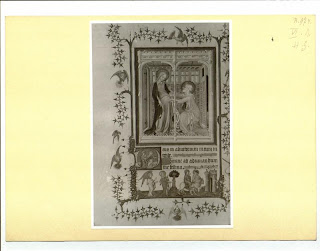The basic facts:
When the Nazis steal everything there is to steal from the dozen or so members of the French branch of the Rothschild family between the summer of 1940 and 1944, part of their haul includes rare—one of a kind—medieval manuscripts, including those manuscripts custom-made for French nobility like “Les Très Riches Heures du Duc de Berri.”
Labeled R 974 by the ERR, the manuscript is shipped out from the Jeu de Paume to the Reich. Nothing more can be said about where it went… until 1951.
 |
| R 974 Source: ERR Project via Bundesarchiv |
Lane Faison, the last director of the Munich Central Collecting Point (MCCP) in what was the US zone of Occupation of Germany, wrote to a Dr. Haars about this rarest of books, wondering if the Gothic manuscript in question had ended up at the MCCP or at the Rare Book repository of Berchtesgaden or still sihpped by Goering on the so-called “Overing Train.” There is only one location in Germany known as Overing; it is in the eastern suburbs of Bremen in northwestern Germany.
An equally appealing tidbit comes to us from Faison about Gisela Limberger, Goering’s former private secretary and unofficial curator of the Goering Collection who herself misappropriate 11 crates of silver and china from the Jeu de Paume. According to Faison, Limberger contacted Rose Valland, France’s Resistance hero who selflessly sacrificed four years of her young life in Nazi-occupied Paris at the Jeu de Paume recording movements of stolen works in and out of the museum. Or was it Valland who contacted Limberger? No matter, Limberger let out that the manuscript might have ended up at Berchtesgaden which prompted Faison to ask Haars about its present whereabouts.
 |
| R 974 Source: ERR Project via Bundesarchiv |
Sadly, one can conclude that, unless the Rothschilds recovered the manuscript after 1951, it is still missing. This brief note is a wonderful example of how small strands of communication can provide numerous insights into the workings and dynamics of plunder and restitution.
However, the ERR card identifies the manuscript as both a “Tagebuch” and “Stundenbuch.” One question to raise is: if there are several versions of the manuscript, which is it since the most elaborate of the duc de Berry’s manuscript lies at the Institut de France in Paris?
By the way, who was/is Dr. Haars? There is no indication of title, rank, organization with whom he was affiliated. One tantalizing clue: a Dietrich Haars and his wife acquired a book business in Winsen (south of Hamburg) in 1951.
 |
| R 974 Source: ERR Project via Bundesarchiv |